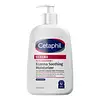What's inside
What's inside
 Key Ingredients
Key Ingredients

 Benefits
Benefits

 Concerns
Concerns

 Ingredients Side-by-side
Ingredients Side-by-side

Colloidal Oatmeal 1%
AbsorbentWater
Skin ConditioningGlycerin
HumectantCaprylic/Capric Triglyceride
MaskingHelianthus Annuus Seed Oil
EmollientPentylene Glycol
Skin ConditioningButyrospermum Parkii Butter
Skin ConditioningCyclopentasiloxane
EmollientCetearyl Alcohol
EmollientSorbitol
HumectantBehenyl Alcohol
EmollientGlyceryl Stearate
EmollientCetyl Alcohol
EmollientTocopheryl Acetate
AntioxidantArginine
MaskingNiacinamide
SmoothingGlyceryl Stearate Citrate
EmollientSodium Polyacrylate
AbsorbentDisodium Ethylene Dicocamide PEG-15 Disulfate
CleansingCaprylyl Glycol
EmollientCeteareth-20
CleansingSodium PCA
HumectantPanthenol
Skin ConditioningCitric Acid
BufferingAllantoin
Skin ConditioningDimethiconol
EmollientOphiopogon Japonicus Root Extract
Skin ConditioningDisodium EDTA
Maltodextrin
AbsorbentSodium Hyaluronate
HumectantCeramide NP
Skin ConditioningPantolactone
HumectantColloidal Oatmeal 1%, Water, Glycerin, Caprylic/Capric Triglyceride, Helianthus Annuus Seed Oil, Pentylene Glycol, Butyrospermum Parkii Butter, Cyclopentasiloxane, Cetearyl Alcohol, Sorbitol, Behenyl Alcohol, Glyceryl Stearate, Cetyl Alcohol, Tocopheryl Acetate, Arginine, Niacinamide, Glyceryl Stearate Citrate, Sodium Polyacrylate, Disodium Ethylene Dicocamide PEG-15 Disulfate, Caprylyl Glycol, Ceteareth-20, Sodium PCA, Panthenol, Citric Acid, Allantoin, Dimethiconol, Ophiopogon Japonicus Root Extract, Disodium EDTA, Maltodextrin, Sodium Hyaluronate, Ceramide NP, Pantolactone
Colloidal Oatmeal 2%
AbsorbentWater
Skin ConditioningGlycerin
HumectantDimethicone
EmollientPetrolatum
EmollientPropanediol
SolventHydroxyethyl Acrylate/Sodium Acryloyldimethyl Taurate Copolymer
Emulsion StabilisingJojoba Esters
EmollientCetyl Alcohol
EmollientAloe Barbadensis Leaf Juice
Skin ConditioningGlyceryl Stearate
EmollientButyrospermum Parkii Butter Extract
Skin ConditioningIsohexadecane
EmollientAvena Sativa Kernel Extract
AbrasiveBisabolol
MaskingZingiber Officinale Root Extract
MaskingC10-30 Cholesterol/Lanosterol Esters
EmulsifyingCeramide Ng
Skin ConditioningHydrolyzed Jojoba Esters
Skin ConditioningTocopheryl Acetate
AntioxidantMagnesium Ascorbyl Phosphate
AntioxidantPanthenol
Skin ConditioningEthylhexylglycerin
Skin ConditioningC12-15 Alkyl Benzoate
AntimicrobialTribehenin
EmollientPotassium Hydroxide
BufferingEDTA
Phenoxyethanol
PreservativePEG-10 Phytosterol
EmulsifyingMethylparaben
PreservativePolysorbate 60
EmulsifyingPalmitoyl Hexapeptide-12
Skin ConditioningColloidal Oatmeal 2%, Water, Glycerin, Dimethicone, Petrolatum, Propanediol, Hydroxyethyl Acrylate/Sodium Acryloyldimethyl Taurate Copolymer, Jojoba Esters, Cetyl Alcohol, Aloe Barbadensis Leaf Juice, Glyceryl Stearate, Butyrospermum Parkii Butter Extract, Isohexadecane, Avena Sativa Kernel Extract, Bisabolol, Zingiber Officinale Root Extract, C10-30 Cholesterol/Lanosterol Esters, Ceramide Ng, Hydrolyzed Jojoba Esters, Tocopheryl Acetate, Magnesium Ascorbyl Phosphate, Panthenol, Ethylhexylglycerin, C12-15 Alkyl Benzoate, Tribehenin, Potassium Hydroxide, EDTA, Phenoxyethanol, PEG-10 Phytosterol, Methylparaben, Polysorbate 60, Palmitoyl Hexapeptide-12
Ingredients Explained
These ingredients are found in both products.
Ingredients higher up in an ingredient list are typically present in a larger amount.
Cetyl Alcohol is a fatty alcohol. Fatty Alcohols are most often used as an emollient or to thicken a product.
Its main roles are:
Though it has "alcohol" in the name, it is not related to denatured alcohol or ethyl alcohol.
The FDA allows products labeled "alcohol-free" to have fatty alcohols.
Learn more about Cetyl AlcoholAccording to INCI standards, this ingredient refers to the physical ground up oatmeal. If you are looking for colloidal oatmeal in skincare, you'll most likely see Avena Sativa Kernel Extract on your ingredient list.
Physical colloidal oatmeal is an abrasive meaning it provides physical exfoliation.
Glycerin is already naturally found in your skin. It helps moisturize and protect your skin.
A study from 2016 found glycerin to be more effective as a humectant than AHAs and hyaluronic acid.
As a humectant, it helps the skin stay hydrated by pulling moisture to your skin. The low molecular weight of glycerin allows it to pull moisture into the deeper layers of your skin.
Hydrated skin improves your skin barrier; Your skin barrier helps protect against irritants and bacteria.
Glycerin has also been found to have antimicrobial and antiviral properties. Due to these properties, glycerin is often used in wound and burn treatments.
In cosmetics, glycerin is usually derived from plants such as soybean or palm. However, it can also be sourced from animals, such as tallow or animal fat.
This ingredient is organic, colorless, odorless, and non-toxic.
Glycerin is the name for this ingredient in American English. British English uses Glycerol/Glycerine.
Learn more about GlycerinGlyceryl Stearate is a mix of glycerin and stearic acid.
It is used to stabilize the mixing of water and oil ingredients. By preventing these ingredients from separating, it can help elongate shelf life. It can also help thicken the product's texture.
As an emollient, it helps soften skin and supports barrier-replenishing ingredients.
In cosmetics, Glyceryl Stearate is often made from vegetable oils or synthetically produced.
This ingredient may not be fungal-acne safe
Fun fact: The human body also creates Glyceryl Stearate naturally.
Learn more about Glyceryl StearatePanthenol is a common ingredient that helps hydrate and soothe the skin. It is found naturally in our skin and hair.
There are two forms of panthenol: D and L.
D-panthenol is also known as dexpanthenol. Most cosmetics use dexpanthenol or a mixture of D and L-panthenol.
Panthenol is famous due to its ability to go deeper into the skin's layers. Using this ingredient has numerous pros (and no cons):
Like hyaluronic acid, panthenol is a humectant. Humectants are able to bind and hold large amounts of water to keep skin hydrated.
This ingredient works well for wound healing. It works by increasing tissue in the wound and helps close open wounds.
Once oxidized, panthenol converts to pantothenic acid. Panthothenic acid is found in all living cells.
This ingredient is also referred to as pro-vitamin B5.
Learn more about PanthenolTocopheryl Acetate is AKA Vitamin E. It is an antioxidant and protects your skin from free radicals. Free radicals damage the skin by breaking down collagen.
One study found using Tocopheryl Acetate with Vitamin C decreased the number of sunburned cells.
Tocopheryl Acetate is commonly found in both skincare and dietary supplements.
Learn more about Tocopheryl AcetateWater. It's the most common cosmetic ingredient of all. You'll usually see it at the top of ingredient lists, meaning that it makes up the largest part of the product.
So why is it so popular? Water most often acts as a solvent - this means that it helps dissolve other ingredients into the formulation.
You'll also recognize water as that liquid we all need to stay alive. If you see this, drink a glass of water. Stay hydrated!
Learn more about Water